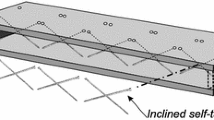Abstract
A smart shear connection system was tested in order to be used in manufactured elements of a lattice of wooden slats and a cross offset. This type of floor element can present advantages both in terms of weight and suitable insulating filler (Adalberth et al. 2001; Kawasaki and Kawai 2006; Kermani and Hairstans 2006; Dodoo et al. 2014). This connection is made to provide a substitute for a glue connection. The shear connection proposed is made by double-sided grooving timber interfaces to form a cross section. A specifically designed test assembly was constructed to measure and guarantee homogeneous contact pressure in interface test specimens. Shear test results are presented and compared in terms of capacity and stiffness with glue connections. The principal conclusions are as follows: the allowable shearing resistance of the grooved timber–timber joints can approximately reach the resistance of glued connections. The stiffness of the joints is improved by increasing the pre-stress applied for holding contact in the assembly. The grooved timber-to-timber joints exhibit non-linear behaviour which dominates the behaviour of the whole system. Therefore, the behaviour of a unit connection must be determined to obtain the mean load-carrying capacity and stiffness of a system with grooved connections.










Similar content being viewed by others
References
Adalberth K, Almgren A, Holleris Petersen E (2001) Life-cycle assessment of four multi-family buildings. Int J Low Energy Sustain Build 2:1–21
Aye L, Ngo T, Crawford RH, Gammampila R, Mendis P (2012) Life cycle greenhouse gas emissions and energy analysis of prefabricated reusable building modules. Energy Build 47:159–168
Bocquet J-F, Pizzi A, Despres A, Mansouri HR, Resch L, Michel D, Letort F (2007) Wood joints and laminated wood beams assembled by mechanically-welded wood dowels. J Adhes Sci Technol 21(3–4):301–317
Brännström M, Manninen J, Oja J (2008) Predicting the strength of sawn wood by tracheid laser scattering. BioResources 3(2):437–451
Chen Y, Lam F (2013) Bending performance of box-based cross-laminated timber systems. J Struct Eng 139(12):04013006
Crocetti R, Gustafsson, PJ, Danielsson H, Emilsson A, Ormarsson S (2010) Experimental and numerical investigation on the shear strength of glulam. In: Proceedings of international council for research and innovation in building and construction, working commission W18 - Timber structures, CIB-W18, vol CIB-W18, Meeting forty-three
Dodoo A, Gustavsson L, Sathre R (2014) Lifecycle primary energy analysis of low-energy timber building systems for multi-storey residential buildings. Energy Build 81:84–97
Fragiacomo M (2005) A finite element model for long-term analysis of timber-concrete composite beams. Struct Eng Mech 20(2):173–190
Fragiacomo M, Lukaszewska E (2011) Development of prefabricated timber concrete composite floor systems. Proc Inst Civ Eng Struct Build 164(2):13
Girard A, Roy N (2003) Dynamique des structures industrielles (Structural Dynamics in Industry) (In French). Hermes Science Publications
Girardon S (2014) Mechanical performances of screwed timber connections, improvement by mechanical preparation of the interfaces: its application to structural member. PhD thesis, Université de Lorraine
Girardon S, Barthram C, Resch L, Bocquet J-F, Triboulot P (2014) Determination of shearing stiffness parameters to design multi-layer spruce beams using welding-through wood dowels. Eur J Wood Prod 72(6):721–733
Girhammar UA (2009) A simplified analysis method for composite beams with interlayer slip. Int J Mech Sci 51(7):515–530
Girhammar UA, Pan DH (2007) Exact static analysis of partially composite beams and beam-columns. Int J Mech Sci 49(2):239–255
Hanhijarvi A, Ranta-Maunus A, Turk G (2005) Potential of strength grading of timber with combined measurement techniques Vtt Publications, p 568
Heimeshoff B (1987) On the calculation of composite beams with slip occurring in the joints. Holz Roh- Werkst 45:237–241
Johansen K (1949) Theory of timber connections. Int Assoc Bridge Struct Eng 9:249–262
Kawasaki T, Kawai S (2006) Thermal insulation properties of wood-based sandwich panel for use as structural insulated walls and floors. J Wood Sci 52(1):75–83
Kermani A, Hairstans R (2006) Racking performance of structural insulated panels. J Struct Eng asce 132(11):1806–1812
Kreuzinger H (1995) Mechanically jointed beams and columns. Timber Eng STEP 1:1–8
Pirazzi C (2005) On the Calculation of screw-laminated timber rib shells. PhD thesis, ENAC, Lausanne
R Development Core Team (2011) R: A Language and Environment for Statistical Computing. R Foundation for Statistical Computing, Vienna
Resch L (2009) Development of local laminated wood construction element using welded-through dowels. PhD thesis, ENSTIB
Shapiro SS, Wilk MB (1965) An analysis of variance test for normality (complete samples). Biometrika 52(3–4):591–611
Simonaho S-P, Silvennoinen R (2006) Sensing of wood density by laser light scattering pattern and diffractive optical element based sensor. J Opt Technol 73(3):170–174
Tomasi R, Crosatti A, Piazza M (2010) Theoretical and experimental analysis of timber-to-timber joints connected with inclined screws. Constr Build Mater 24(9):1560–1571
Viguier J, Jehl A, Collet R, Bleron L, Meriaudeau F (2014) Improving strength grading of timber by grain angle measurement and mechanical modeling. Wood Mater Sci Eng (ahead-of-print):1–12
Wang S-Y, Chen J-H, Tsai M-J, Lin C-J, Yang T-H (2008) Grading of softwood lumber using non-destructive techniques. J Mater Process Technol 208(1):149–158
Zarnani P, Quenneville P (2014) Wood load-carrying capacity of timber connections: an extended application for nails and screws, pp 167–179
Author information
Authors and Affiliations
Corresponding author
Rights and permissions
About this article
Cite this article
Girardon, S., Bocquet, JF. Mechanical behaviour of pre-stressed spruce timber–timber 2.5-mm-step grooved connections under shearing tests. Eur. J. Wood Prod. 75, 719–727 (2017). https://doi.org/10.1007/s00107-016-1135-x
Received:
Published:
Issue Date:
DOI: https://doi.org/10.1007/s00107-016-1135-x




